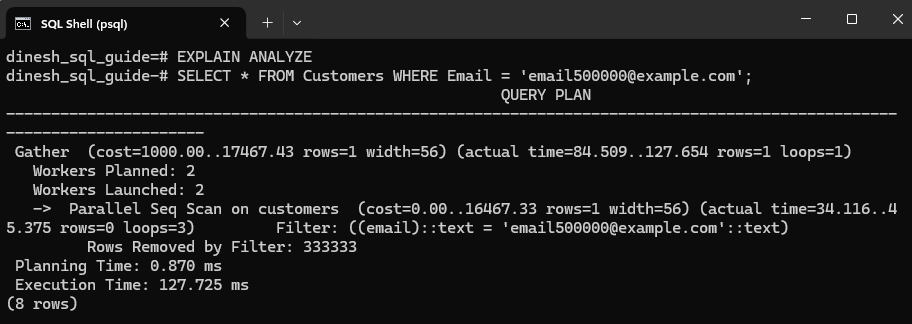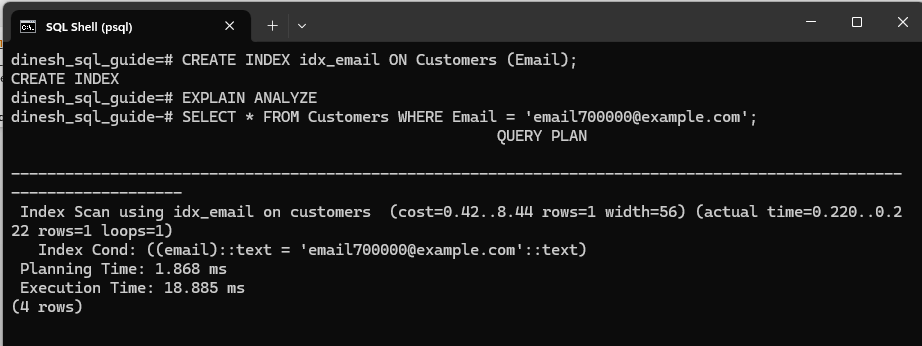Speeding Up Queries with PostgreSQL B-tree Indexing
A B-tree index in PostgreSQL can significantly improve query performance by making data retrieval faster. Think of this index like the index of a nonfiction book. If you want to find information about a flower named Blue orchid, you'd flip to the index at the end of the book, look for Blue orchid, and find the page numbers where it's discussed. Similarly, in a database, a B-tree index helps PostgreSQL quickly locate the rows associated with the data you're searching for, instead of scanning the entire table.
In this walkthrough, we'll focus on the default B-tree index to demonstrate how it improves query performance, step by step.
Create a Table
Create the Customers table:
CREATE TABLE Customers (
ID SERIAL PRIMARY KEY,
FirstName VARCHAR(50),
LastName VARCHAR(50),
Email VARCHAR(100)
);
Insert a Large Data Set
Indexes are especially useful when working with large datasets because they help speed up data retrieval. To demonstrate this, we'll insert a substantial dataset into the Customers table.
You can use a single query with the generate_series() function to insert multiple rows in PostgreSQL:
INSERT INTO Customers (FirstName, LastName, Email)
SELECT
'FirstName' || g AS FirstName,
'LastName' || g AS LastName,
'email' || g || '@example.com' AS Email
FROM generate_series(1, 1000000) g;
This SQL code performs a bulk insert into the Customers table. It generates 1,000,000 rows using generate_series(1, 1000000), where each row has a unique FirstName, LastName, and Email constructed by concatenating the strings FirstName, LastName, and email with the generated sequence number. The result is one million new customer records.
For instance, this screenshot shows the first 11 records from the table after data has been inserted:

Run a Query Without an Index
Run a query without creating an index to observe performance:
EXPLAIN ANALYZE
SELECT * FROM Customers WHERE Email = 'email500000@example.com';
When I ran the query, I got this result:

The database performed a Parallel Sequential Scan, which examines every row to locate the matching result. While this approach is acceptable for small datasets, it becomes increasingly inefficient and time-consuming as the table size grows. Note the Execution Time, which is measured at 127.725 ms, highlighting the impact of scanning the entire dataset without indexing.
Create an Index
Create an index on the Email column:
CREATE INDEX idx_email ON Customers (Email);
Run a Query Again
Now that we've created the index, run a query again:
EXPLAIN ANALYZE
SELECT * FROM Customers WHERE Email = 'email700000@example.com';
This time I got this result from the query:

Note the difference: Execution time has considerably reduced to 18.885 ms and the query now uses an Index Scan, dramatically reducing the number of rows scanned.
Rather than scanning every row in the table to locate email700000@example.com, as is the case with a sequential scan in a previous step, PostgreSQL now uses the index on the Email column to efficiently pinpoint the exact row. By using the index, it quickly jumps to the relevant entry for email700000@example.com, retrieves the row, and returns the result, significantly speeding up the query.
Let's once again look at the comparison:
| Scenario | Scan Type | Execution Time |
|---|---|---|
| Without Index | Sequential Scan | 127.725 ms |
| With Index | Index Scan | 18.885 ms |
Congratulations! We've understood the difference between a sequential scan and an index scan, and we've seen how an index can significantly speed up query performance.